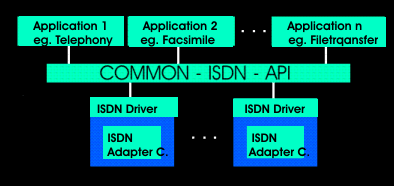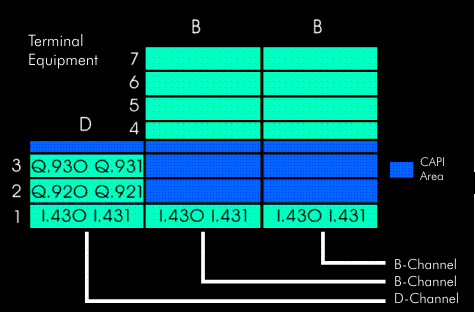common application programming interface (ISDN) (CAPI)
For ISDN communication, the Common Application Programming Interface (CAPI) has become the standard for the interface between the application and the adapter. CAPI represents a programming interface that allows easy access from any number of applications to ISDN adapter cards and ensures unrestricted use of their functionality through a standardized set of commands.
The functions of the CAPI interface
On the one hand, CAPI represents a software interface, on the other hand, it also provides corresponding communication protocols in the B channel and lies as a communication interface above the network layer.
This makes it possible to connect higher protocols and specific ISDN applications to ISDN via a standardized software interface. CAPI forms the basis for the modular development of software applications in ISDN systems
Important features of the CAPI interface are the support of multiple B-channels for data and voice, the handling of the B-channel protocol for connection control, the selection of different services, the support of multiple logical connections over one physical connection, the support of multiple applications, the use of multiple communication protocols, and the support of one or more basic or primary multiplex connections.
The different CAPI variants
The first CAPI version, 1.1 of 1989, was designed to support call establishment and termination as well as data transmission. Since these functionalities were not sufficient in the medium term to support the special features of data communication, CAPI was further developed and led to the version CAPI+ in 1991, which includes important functions of data security and data compression. Today, CAPI is available for the Windows, OS/2, Unix and Netwareoperating systems.
Currently, CAPI V1.1, CAPI+ V1.1and CAPI V2.0 from 1994 exist. The CAPI interface version 1.1 does not include structures to support packet-switched networks, since the interface was developed following the national 1TR6 protocol for the D channel. The functions of CAPI V.1.1 are call setup and disconnection, transmission functions with the layer 2 B-channel protocols High Level Data Link Control( HDLC), Synchronous Data Link Control( SDLC), X.25SLP, X.25 Btx and the layer 3 B-channel protocols X.25 DTE-DTE, T.70NL and T.90. The additional functions of the Plus version are data security functions such as encryption, authentication and digital signature, compression, channel bundling and multi- frequency dialing.


